
Original Link: https://www.anandtech.com/show/2255
Intel Core 2 Duo E6750 Preview: The Desktop Gets a 1333MHz FSB
by Anand Lal Shimpi on June 25, 2007 2:57 AM EST- Posted in
- CPUs
By the end of Summer, Intel's Conroe lineup will have ballooned from a meager five processors at launch to at least different 14 models. The once simple model number system is now well on its way to being the complicated mess that plagued the P4's system before it.
First it was the introduction of the value E4xxx series, then the larger cache Exx20 series, followed by the even cheaper E2xxx CPUs and now the new 1333MHz FSB processors.
The new 1333MHz FSB CPUs will end in the number 50 (e.g. E6750), with the exception of the E6540 which is also a 1333MHz CPU. Although Intel isn't announcing pricing at this point, we don't expect the new 1333MHz FSB CPUs to cost any more than their predecessors; in other words, we expect the E6750 to carry the same price tag as the E6700 does. We've included the post July 22nd price cuts for the unreleased Intel processors in the table below (note that current processors will fall in price as well, although the table reflects present day pricing for currently available CPUs), as well as pricing for chips to be released in Q4:
| CPU | Clock Speed | FSB | L2 Cache | Availability | Pricing |
| Intel Core 2 Extreme X6800 | 2.93GHz | 1066 | 4MB | Now | $999 |
| Intel Core 2 Duo E6850 | 3.00GHz | 1333 | 4MB | Q3 | $266 |
| Intel Core 2 Duo E6750 | 2.66GHz | 1333 | 4MB | Q3 | $183 |
| Intel Core 2 Duo E6700 | 2.66GHz | 1066 | 4MB | Now | $316 |
| Intel Core 2 Duo E6600 | 2.40GHz | 1066 | 4MB | Now | $224 |
| Intel Core 2 Duo E6550 | 2.33GHz | 1333 | 4MB | Q3 | $163 |
| Intel Core 2 Duo E6540 | 2.33GHz | 1333 | 4MB | Q3 | $163 |
| Intel Core 2 Duo E6420 | 2.13GHz | 1066 | 4MB | Now | $183 |
| Intel Core 2 Duo E6400 | 2.13GHz | 1066 | 2MB | Now | $183 |
| Intel Core 2 Duo E6320 | 1.86GHz | 1066 | 4MB | Now | $163 |
| Intel Core 2 Duo E6300 | 1.86GHz | 1066 | 2MB | Now | $163 |
| Intel Core 2 Duo E4600 | 2.40GHz | 800 | 2MB | Q4 | $133 |
| Intel Core 2 Duo E4500 | 2.20GHz | 800 | 2MB | Q3 | $133 |
| Intel Core 2 Duo E4400 | 2.00GHz | 800 | 2MB | Now | $133 |
| Intel Core 2 Duo E4300 | 1.80GHz | 800 | 2MB | Now | $113 |
| Intel Pentium E2180 | 2.00GHz | 800 | 1MB | Q4 | $84 |
| Intel Pentium E2160 | 1.80GHz | 800 | 1MB | Now | $84 |
| Intel Pentium E2140 | 1.60GHz | 800 | 1MB | Now | $74 |
Intel sent out samples of its Core 2 Duo E6750 ahead of their scheduled availability as a preview (and probably to jab at its competitor a bit), so the processor we're previewing won't be available for a little while. Intel's internal roadmaps show Q3 as the timeframe to expect its 1333MHz FSB CPUs, but Intel's official statement is that these CPUs will be available "later this summer."
 |
 |
Keep in mind that AMD's pricing is keeping the company's lineup quite competitive with Intel below $300. You can buy all Socket-AM2 AMD processors for less than $300, resulting in great price/performance from the guys in green.
| CPU | Clock Speed | L2 Cache | Price |
| AMD Athlon 64 X2 6000+ | 3.0GHz | 1MBx2 | $241 |
| AMD Athlon 64 X2 5600+ | 2.8GHz | 1MBx2 | $188 |
| AMD Athlon 64 X2 5200+ | 2.6GHz | 1MBx2 | $178 |
| AMD Athlon 64 X2 5000+ | 2.6GHz | 512KBx2 | $167 |
| AMD Athlon 64 X2 4800+ | 2.5GHz | 512KBx2 | $136 |
| AMD Athlon 64 X2 4400+ | 2.3GHz | 512KBx2 | $121 |
| AMD Athlon 64 X2 4000+ | 2.1GHz | 512KBx2 | $104 |
| AMD Athlon 64 X2 3800+ | 2.0GHz | 512KBx2 | $83 |
| AMD Athlon 64 X2 3600+ | 1.9GHz | 512KBx2 | $73 |
Note that AMD will respond with its own set of price cuts in late July to keep the landscape competitive after Intel's cost cutting measures.
Tell it To Me Straight Anand: Is it Any faster?
The beauty of these FSB launches at equivalent clock speeds is that we show you a single chart that summarizes the performance impact of the faster FSB across our entire bench suite. At one single glance you can figure out whether or not there's anything worth getting excited about:
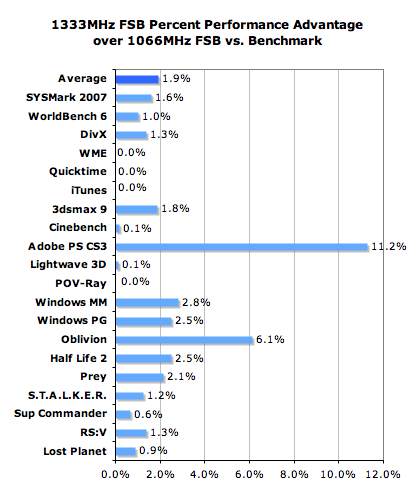
Overall, the 1333MHz FSB doesn't do much for dual core processors. Over the 20 benchmarks we sampled for this chart, the 1333MHz FSB gave us an average improvement of 1.9% over the 1066MHz FSB. There are two unique outliers in the chart: Oblivion with a 6.1% improvement and Photoshop CS3 with an 11.2% increase in performance. Both of these benchmarks are hand timed so the variance between runs is greater than normal, and we suspect that may be the reason for some of the larger than normal impact of the faster FSB but after multiple subsequent runs we were left with the same results.
Keep in mind the fundamental rules of FSB performance: clock speed, number of cores, memory bandwidth and microprocessor architecture all play important roles in the impact of a faster FSB. The clock speeds Intel is launching its 1333MHz FSB processors are basically the same ones that Intel first introduced the Core 2 at; we weren't FSB bottlenecked back then, thus there's no reason to expect a huge increase in performance by bumping the FSB today. Quad-core CPUs may see a performance boost, but we'll have to wait until later to find out exactly what that improvement would be; we have a feeling that the overall performance impact will be similarly unimpressive given the relatively limited number of desktop applications that can take full advantage of four cores.
As Intel ramps up clock speed and continues its transition to quad-core the 1333MHz FSB will be more important, but today it's by no means a necessary feature. There's a bigger performance impact from having more L2 cache (e.g. 4MB vs. 2MB) than from the 1333MHz FSB, which is great news for present day Core 2 owners.
Under load, the faster FSB also doesn't increase power consumption much at all:
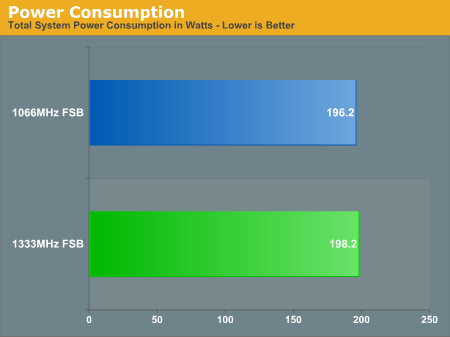
An increase of 2W isn't much for a desktop platform, although Intel could arguably implement a variable speed FSB from its latest Centrino platform if power consumption ever becomes an issue.
The Test
With the 1333MHz vs. 1066MHz FSB issue laid to rest, the rest of this article will be a recap of AMD vs. Intel performance. We compared the E6750, E6700 and E6420 from Intel to the X2 6000+ and 5600+ from AMD. The 5600+ is closest in price to the E6420, while the 6000+ is the closest AMD offers to something at the E6700 price level.
Note that SYSMark 2007 only runs on 32-bit versions of Windows, so all of the tests for this article were conducted under Windows Vista Ultimate 32-bit.
| CPU: | AMD Athlon 64 X2 6000+ (3.0GHz/1MBx2) AMD Athlon 64 X2 5600+ (2.8GHz/1MBx2) Intel Core 2 Duo E6750 (2.66GHz/1333MHz) Intel Core 2 Duo E6700 (2.66GHz/1066MHz) Intel Core 2 Duo E6420 (2.13GHz/1066MHz) |
| Motherboard: | Gigabyte GA-P35C-DS3R (Intel P35) ASUS M2N32-SLI Deluxe (nForce 590 SLI) |
| Chipset: | Intel P35 NVIDIA nForce 590 SLI |
| Chipset Drivers: | Intel 8.1.1.1010 (Intel) Integrated Vista Drivers (NVIDIA) |
| Hard Disk: | Seagate 7200.9 300GB SATA |
| Memory: | Corsair XMS2 DDR2-800 4-4-4-12 (1GB x 2) |
| Video Card: | NVIDIA GeForce 8800 GTX |
| Video Drivers: | NVIDIA ForceWare 158.18 |
| Desktop Resolution: | 1600 x 1200 |
| OS: | Windows Vista Ultimate 32-bit |
General Performance - SYSMark 2007
SYSMark has always pushed the envelope of desktop PC usage patterns, and the latest version is no exception. Intel's Core 2 processors do exceptionally well here, with the E6420 pulling slightly ahead of the 5600+ in the overall score; looking at the individual tests you'll see that AMD ends up ahead in the Video Creation and 3D tests, with Intel taking the E-Learning and Productivity suites. Overall the two equally priced processors perform very similarly, so you can't go wrong with either one.
The impact of the 1333MHz FSB is minimal throughout the entire suite.
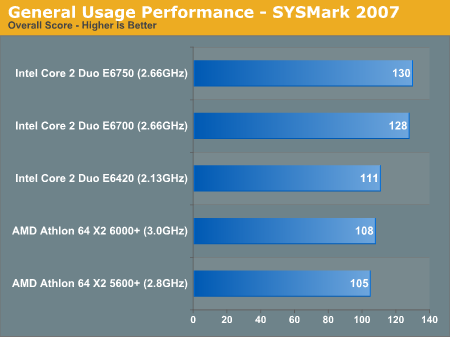
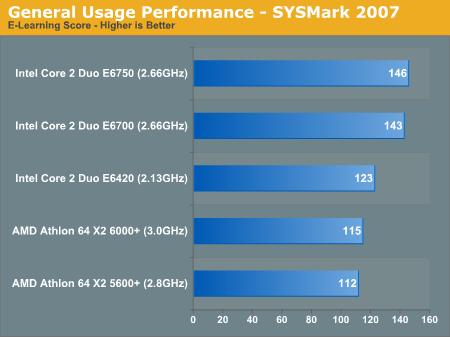
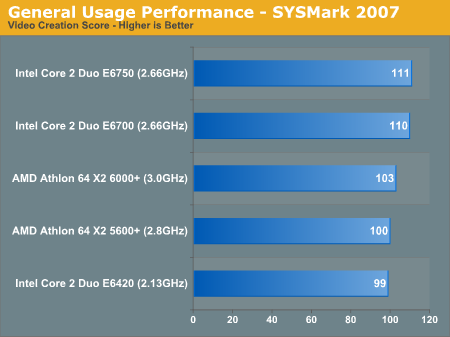
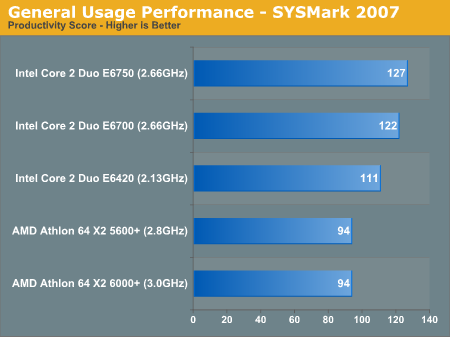
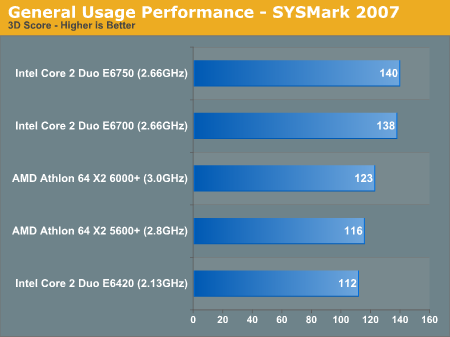
General Performance - PC WorldBench 6
PC WorldBench 6 focuses mostly on single application performance, with only a single multitasking benchmark in the entire suite. Here we see performance parity between the E6420 and AMD's X2 5600+, and very little impact from the 1333MHz FSB:

Media Encoding Performance
Intel continues to hang on to a performance advantage in our DivX encoding test, although the E6420/5600+ battle remains a close one:
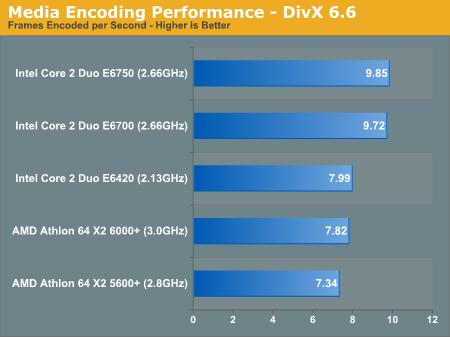
AMD's 5600+ pulls ahead of Intel's E6420 in our Windows Media Encoder test, which also shows no performance improvement due to the faster FSB for Intel:
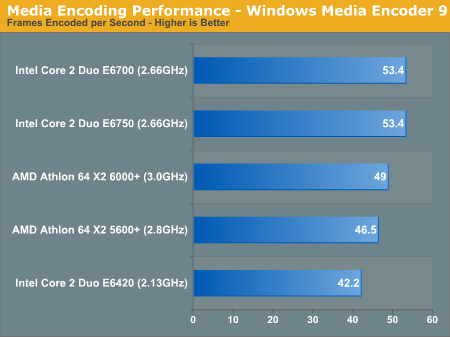
Our Quicktime H.264 test is using a different source file than we have in previous articles, it's now using the same source file as our WME test, but the process is the same. The end result is very similar to what we saw in our DivX test:
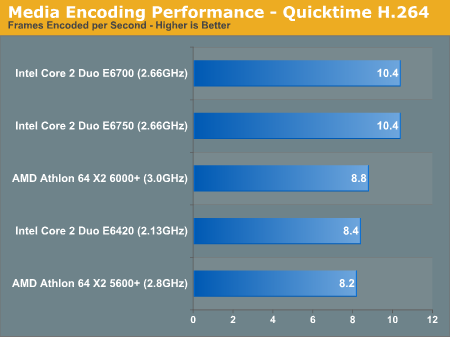
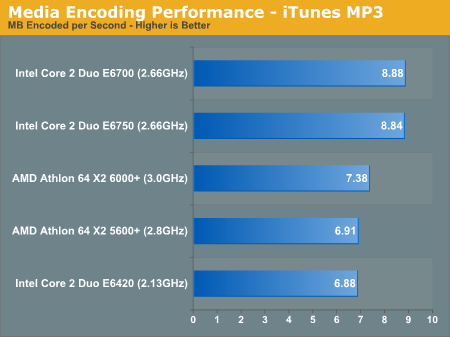
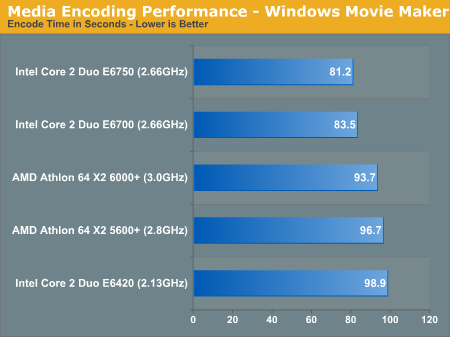
3D Rendering Performance
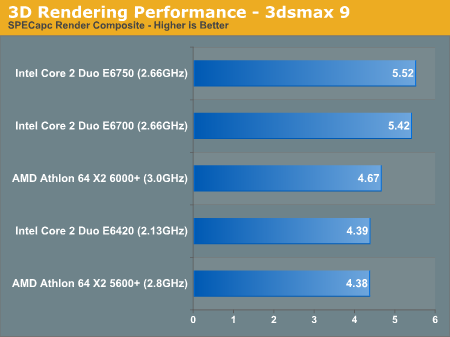
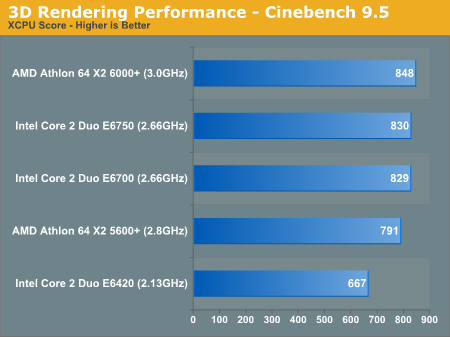
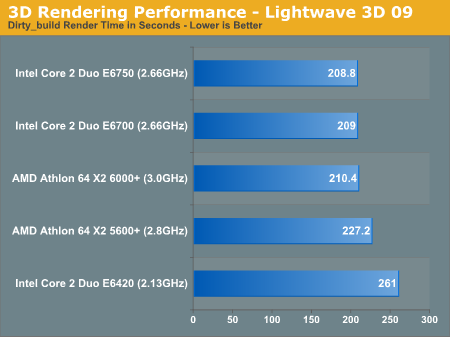
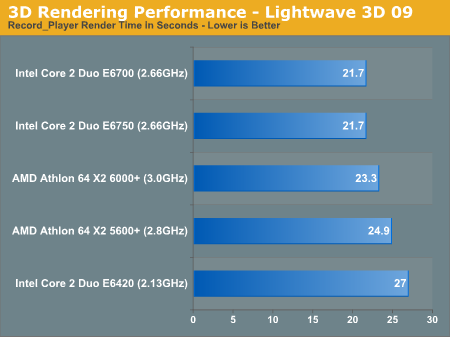
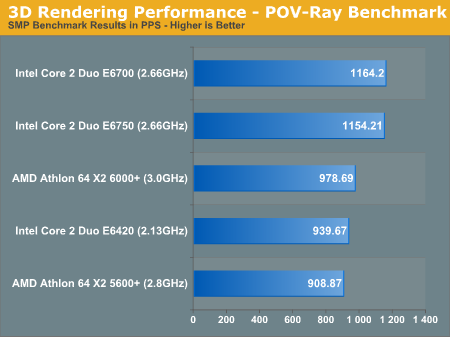
Photo Processing Performance
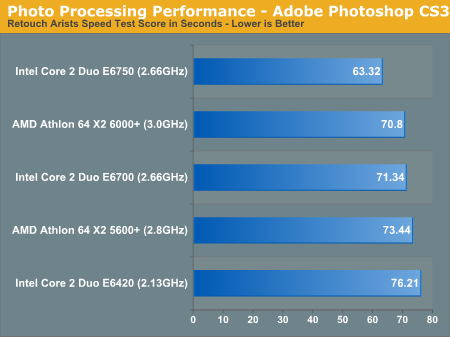

Gaming Performance
We're testing with a handful of new titles in today's review, many of which are far from CPU bound even at relatively low (by today's standards) resolutions. For our S.T.A.L.K.E.R. and Supreme Commander tests we had to reduce the in-game resolution to 1024 x 768, while Rainbow Six: Vegas and Lost Planet both required 800 x 600 in order to produce measurable differences between these CPUs.
On the one hand, this is good news for those looking to build gaming PCs on lower end processors. On the other hand, it means that we have to test with less real world settings in our CPU reviews to accurately compare overall gaming performance of modern day CPUs. The CPU/GPU boundry pendulum will continuously swing from one end to the other, we're simply at a point today where even the almighty GeForce 8800 GTX can't run everything perfectly smoothly at 1600 x 1200.
As CPUs and GPUs converge, games will undoubtedly become even more compute bound, but it's difficult to predict what effect this will have (if any) on the balance between sequential and highly parallel general purpose processing.
Our first 3D game test is our walkthrough of Bruma in the popular RPG Oblivion. This test was run at 1600 x 1200 with Very High quality defaults selected from Oblivion's launcher. FRAPS was used in this benchmark:

Oblivion was one of the two benchmarks that showed a significant performance improvement due to the faster 1333MHz FSB. Looking at the E6420 vs. 5600+ comparison, AMD actually pulls ahead here thanks to its aggressive pricing.
We ran Half Life 2: Episode One at 1600 x 1200, with all settings at their maximum values with the exception of AA/anisotropic filtering, which we left disabled.
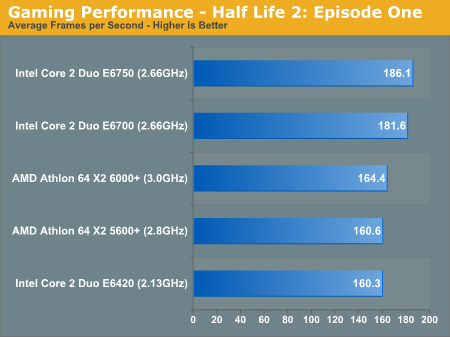
A small improvement for the 1333MHz FSB, and AMD continues to win the performance battle at ~$180.
We ran Prey at 1600 x 1200 with High Quality textures, all detail settings were set to their highest options, no AA, and 8X aniso:
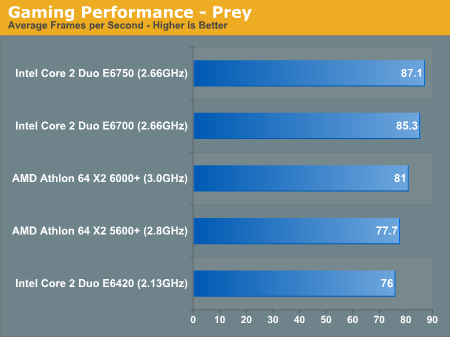
S.T.A.L.K.E.R. was tested at 1024 x 768 with full dynamic lighting enabled and high quality detail settings:
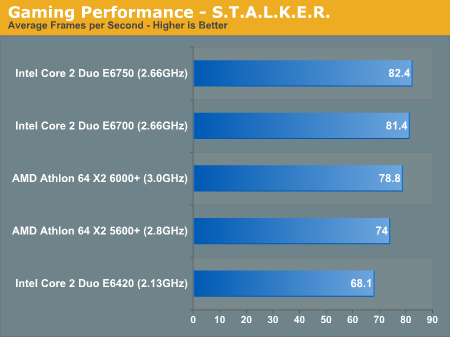
We ran Supreme Commander at 1024 x 768 with medium quality presets. We ran a subset of the built in performance test, specifically we only used the third performance test in the script as it was the most CPU bound.
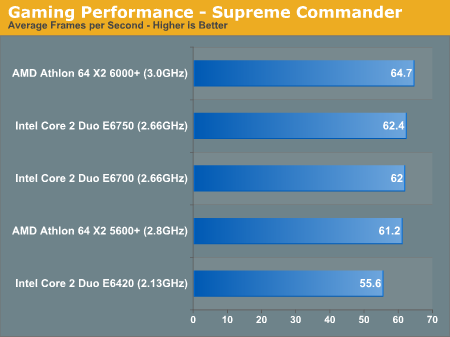
Rainbow Six: Vegas proved to be particularly GPU bound, even at 800 x 600. We left most detail options enabled/high, with the exception of the eye effect setting.

Capcom's Lost Planet demo is available in both DX9 and DX10 flavors, but for this review we used the DX9 version given that we've not been able to find any real benefit to running the DX10 version. Just like RS:V, we had to run Lost Planet at 800 x 600 with a mixture of high/medium quality settings:
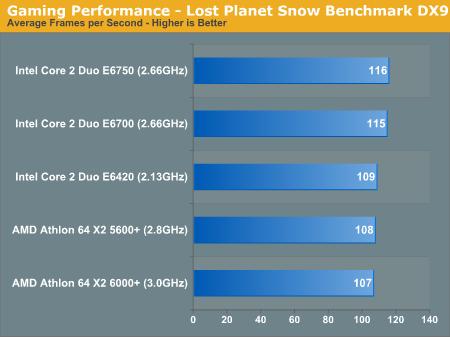
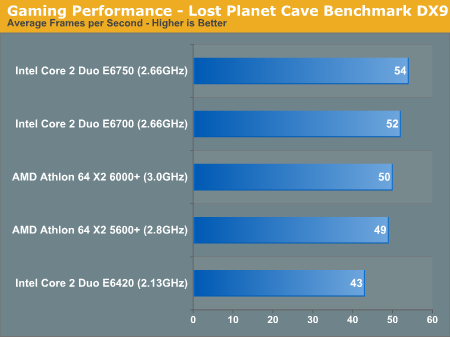
Overclocking and Final Words
Our Core 2 Duo E6750 sample was a particularly great overclocker, at stock voltage with a retail Intel heatsink/fan we were able to run the system at 3.68GHz (460 x 8.0):

With further voltage tweaking slightly faster speeds should be possible, but at default voltage we were quite impressed. Whether or not this is a testament to the maturity of Intel's 65nm process has yet to be seen, but this next batch of Core 2 processors that will be appearing in the summer could be great overclockers. It's not a tremendous surprise given that Intel's 65nm process should be quite mature at this point, as Intel is on the cusp of introducing its first 45nm processors. Intel has always been strong in the manufacturing department, but now it's more like the good ol' Pentium/Pentium II/Pentium III days of overclocking because it is shipping CPUs we actually want to overclock.
While we await the official release of Intel's 1333MHz FSB CPUs, we now know not to expect much from them, which is why we're expecting to see a price-parity with current 1066MHz chips from Intel. It looks like the big performance increase for Intel this year will come from Penryn, and if reports from Taiwan are to be believed, the performance crown may not change hands this year after all.
Our brief comparison between AMD and Intel at the $180 price point continues to illustrate how it's not architecture, but pricing that can actually determine a recommendation at this point. While AMD is still competing using its original K8 architecture, its pricing is such that its CPUs can easily stand up to Intel at price points less than $300. Once Penryn hits, the same may no longer hold true but for now you can't go wrong with either manufacturer; it's not a bad time to be buying a CPU.







